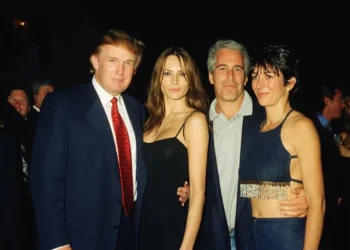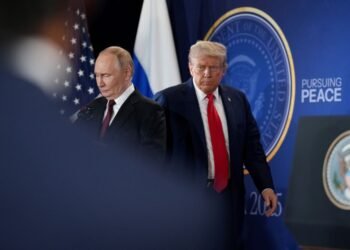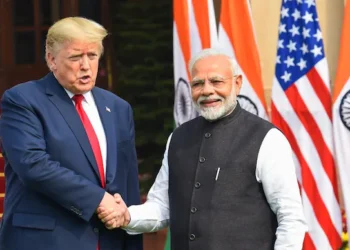BY PC Bureau
U.S. President Donald Trump strode into the spotlight at the National Republican Congressional Committee’s donor dinner on Tuesday evening, April 8, 2025, with a speech dripping in bravado and scorn. Before a crowd of party faithful, he crowed that his new trade policies have nations “queuing up” to negotiate, painting a vivid picture of world leaders humbled by his tactics. “They’re calling us up, kissing my a**,” Trump declared, mimicking their pleas in a mocking falsetto: “Please, sir, make a deal—I’ll do anything!” The room erupted as he took a swipe at Republicans pushing for Congress to reclaim trade talks. “You don’t negotiate like I do,” he sneered, cementing his image as the ultimate dealmaker.
The swagger came with a bombshell: starting April 9, 2025, U.S. tariffs on Chinese imports will leap to a staggering 104%, a move confirmed by the White House earlier that day. It’s the latest escalation in Trump’s unrelenting trade war with Beijing, a campaign rooted in his long-standing grievance that China’s economic rise has come at America’s expense. The announcement follows Trump’s earlier ultimatum—slap an extra 50% on Chinese goods if Beijing didn’t roll back its own retaliatory tariffs. China didn’t blink, and now Trump’s delivering what he calls a “harder punch.”
ALSO READ: Mumbai 26/11 Suspect Faces Justice: Rana’s Return Nears
White House Press Secretary Karoline Leavitt framed the tariff hike as both punishment and strategy. “The President believes China wants a deal—they’ll have to make one,” she said. “Retaliating was their mistake. When America’s hit, he hits back tougher—that’s why 104% tariffs start tonight. But if they come to negotiate, he’ll be gracious, generous even.” The administration sees this as a test of wills, betting China’s economy, heavily reliant on U.S. markets, will buckle first.
President Trump: “These countries are calling us up—kissing my ass; they are dying to make a deal.”pic.twitter.com/fWIGpDafNR
— Department of Government Efficiency News (@DOGE__news) April 9, 2025
China’s Deepening Defiance
Beijing, however, shows no sign of folding. China’s Foreign Ministry blasted the tariffs as “economic coercion” and a “violation of free trade principles,” vowing to “fight to the end” against what it deems predatory U.S. policies. State-run Global Times called Trump’s move “a declaration of war on the global economy,” accusing him of using tariffs as a cudgel to suppress China’s technological and industrial ascent. In response, Chinese officials are mulling a broad retaliation package—potentially targeting U.S. exports like soybeans, aircraft, and semiconductors, alongside tightening rare earth mineral exports, a chokehold on materials vital to tech and defense sectors.
ALSO READ: Manipur MLA’s Drug Mafia Assault Story Faces Fierce Denial
This isn’t Trump’s first tango with China. His first term saw tariffs climb to 25% on billions in Chinese goods, sparking a tit-for-tat that rattled markets. The 104% rate, though, is a quantum leap, aimed at everything from consumer electronics to industrial machinery. Experts peg the affected trade volume at over $500 billion annually, a figure that could kneecap China’s export engine—already strained by slowing domestic growth and a property sector crisis. Yet China’s not defenseless: its $1.2 trillion in U.S. Treasury holdings give it leverage to unsettle American debt markets if pushed too far.
The Stakes and Fallout
The tariff war’s timing is striking. It lands amid diplomatic churn—India’s push to extradite Mumbai attack suspect Tahawwur Rana got U.S. approval in February 2025, just before Prime Minister Narendra Modi’s Washington visit, signaling Trump’s willingness to flex muscle globally. Some see the China tariffs as a parallel message: no rival, economic or otherwise, will go unchallenged. But the risks are steep. U.S. retailers warn of price surges—think $1,000 iPhones or doubled clothing costs—while manufacturers reliant on Chinese parts foresee production snarls. Farmers, still scarred by China’s 2018 soybean boycott, brace for another hit.
China’s counterstrategy is taking shape. Beyond tariffs, Beijing’s hinted at non-economic moves: restricting U.S. firms’ access to its market, ramping up cyber operations, or even cozying up to Russia for a united front. President Xi Jinping, facing internal pressure to project strength, has rallied domestic support with nationalist fervor, framing Trump’s policies as an assault on China’s sovereignty. Analysts predict a prolonged standoff—neither side can easily retreat without losing face.
Trump, meanwhile, revels in the chaos. “They’ve ripped us off for decades,” he told the donors, casting the tariffs as a patriotic crusade. Critics—Democrats, some GOP fiscal hawks, and business lobbies—call it a gamble that could tip the U.S. into recession if China’s retaliation bites deep. Congressional murmurs about reining in Trump’s tariff powers grow louder, but he shrugs them off, betting his base loves the fight.
As April 9 dawns with 104% duties in force, the world braces for impact. From Rana’s looming trial to this tariff tempest, Trump’s weaving a narrative of unyielding strength—whether it holds or unravels remains the trillion-dollar question.













